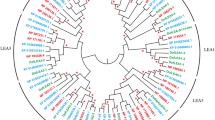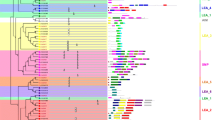Abstract
Lea genes code for mRNAs and proteins that are late embryogenesis abundant in higher plant seed embryos. They appear to be ubiquitous in higher plants and may be induced to high levels of expression in other tissues and at other times of ontogeny by ABA and/or desiccation. Presented here are the genomic and cDNA sequences for 6 of these genes from cotton seed embryos and the derived amino acid sequences of the corresponding proteins.
The Lea genes contain the standard sequence features of eucaryotic genes (TATA box and poly (A) addition sequences) and have 1 or more introns. Sequences differences between cDNA and genomic DNA confirm the existence of small multigene families for several Lea genes. The amino acid composition and sequence for the Lea proteins are unusual. Five are extremely hydrophilic, four contain no cys or trp and 4 have sequence domains that suggest amphiphilic helical structures. Hypothetical functions in desiccation survival, based on amino acid sequence, are discussed.
Similar content being viewed by others
References
Dure LIII, Greenway SC, Galau GA: Developmental biochemistry of cottonseed embryogenesis and germination: Changing mRNA populations as shown by in vitro and in vivo protein synthesis. Biochem 20: 4162–4168 (1981).
Dure LIII, Galau GA, Chlan CA, Pyle J: Developmentally regulated gene sets in cotton embryogenesis. In: Goldberg RB (ed.) Plant Molecular Biology. Alan R. Liss, New York (1983), pp. 331–342.
Dure LIII, Chlan CA, Baker JC, Galau GA: Gene sets active in cottonseed embryogenesis. In: Davidson EH, Firtel RA (eds) Molecular Biology of Development. Alan R. Liss, New York (1984), pp. 591–600.
Galau GA, Hughes DW, Dure LIII: Abscisic acid induction of cloned cotton late embryogenesis abundant (Lea) mRNAs. Plant Mol Biol 7: 155–170 (1986).
Baker JC, Dure LIII: DNA and amino acid sequences of some ABA responsive genes expressed in late embryogenesis in cotton. In: Fox JE (ed.) Molecular Biology of Plant Growth Control. Alan R. Liss, New York (1987), pp. 51–62.
Galau GA, Bijaisoradat N, Hughes DW: Accumulation kinetics of cotton late embryogenesis — abundant (Lea) mRNAs and storage protein mRNAs: coordinate regulation during embryogenesis and the role of abscisic acid. Dev Biol 123: 198–212 (1987).
Ihle JN, Dure LIII: Hormonal regulation of translation inhibition requiring RNA synthesis. Biochem Biophys Res Comm 38: 995–1001 (1970).
Ihle JN, Dure LIII: Developmental biochemistry of cottonseed embryogenesis and germination. III Regulation of the biosynthesis of enzymes utilized in germination. J Biol Chem 247: 5048–5055 (1972).
Dure LIII: Seed formation. Ann Rev Plant Physiol 26: 259–278 (1975).
Galau GA, Chlan CA, Dure LIII: Developmental biochemistry of cottonseed embryogenesis and germination. XVI Analysis of the principal cotton storage protein gene family with cloned cDNA probes. Plant Mol Biol 2: 189–198 (1983).
Maxam AM, Gilbert W: Sequencing end-labelled DNA with base-specific chemical cleavages. In: Grossman L, Moldave K (eds) Methods in Enzymology, Vol. 65, Academic Press, New York (1980), pp. 449–560.
Kyte J, Doolittle RF: A simple method for displaying the hydropathic character of a protein. J Mol Biol 157: 105–132 (1982).
Berk AJ, Sharp PA: Sizing and mapping of early adenovirus mRNAs by gel electrophoresis of S1 endonuclease-digested hybrids. Cell 12: 721–732 (1977).
Mundy J, Chua NH: Abscisic acid and water stress induce the expression of a novel rice gene. EMBO J, in press (1988).
Seffenes DV, Thomas T: personal communication.
Crouch M, Harada J: personal communication.
VonHeijnes G: Patterns of amino acids near signal cleavage sites. Eur J Biochem 133: 17–21 (1983).
Tanford C: The hydrophobic effect and the organization of living matter. Science 200: 1012–1018 (1978).
Creighton TE: Proteins; Structures and Molecular Properties, Chapter 4. W.H. Freeman, New York (1983).
Webb SJ: Bound Water in Biological Integrity. Charles C. Thomas, Springfield, IL (1965).
Crowe JH, Crowe LM: Stabilization of membranes in anhydrobiotic organisms. In: Leopold AC (ed.) Membranes, Metabolism and Dry Organisms. Comstock Publ. Assoc. Ithaca, Ny (1986), pp. 188–209.
Crowe JH, Crowe LM, Chapman D: Preservation of membranes in anhydrobiotic organisms: the role of trehalose. Science 223: 701–703 (1984).
Caffrey M, Fonseca V, Leopold AC: Lipid-sugar interactions. Plant Physiol 86: 754–758 (1988).
Schiffer M, Edmundson AB: Use of helical wheels to represent the structures of proteins and to identify segments with helical potential. Biophys J 7: 121–135 (1967).
Author information
Authors and Affiliations
Rights and permissions
About this article
Cite this article
Baker, J., Van dennSteele, C. & Dure, L. Sequence and characterization of 6 Lea proteins and their genes from cotton. Plant Mol Biol 11, 277–291 (1988). https://doi.org/10.1007/BF00027385
Received:
Accepted:
Issue Date:
DOI: https://doi.org/10.1007/BF00027385




